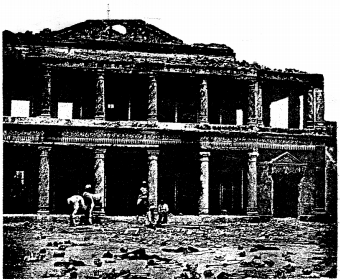Here we are providing Online Education Class 12 Hindi Important Extra Questions and Answers Vitan Chapter 1 सिल्वर वैडिंग. Important Questions for Class 12 Hindi are the best resource for students which helps in class 12 board exams.
Online Education for सिल्वर वैडिंग Class 12 Important Extra Questions Hindi Vitan Chapter 1
प्रश्न 1.
यशोधर बाबू दिल्ली कब और क्यों आए ?
उत्तर
यशोधर बाबू ने अल्मोड़ा के रेम्जे स्कूल में मैट्रिक की परीक्षा पास की। इसके बाद वे दिल्ली आ गए क्योंकि उन्हें आजीविका चलाने के लिए किसी नौकरी की तलाश थी।
प्रश्न 2.
दिल्ली आने पर यशोधर बाबू की सहायता किसने की और कैसे ?
उत्तर
दिल्ली आने पर यशोधर बाबू की सहायता किशनदा ने की। किशनदा ने यशोधर बाबू को रहने के लिए घर ही नहीं दिया बल्कि उसे मेस में रसोइया बनाकर भी रख लिया। उन्होंने यशोधर को पचास रुपए उधार भी दिए ताकि वह अपने लिए कपड़े बनवा सके तथा अपने गाँव पैसा भेज सके। इसके बाद नौकरी की उम्र होने पर किशनदा ने उन्हें अपने दफ्तर में अपने नीचे नौकरी पर लगवा दिया।
प्रश्न 3.
यशोधर साइकिल छोड़कर दफ्तर पैदल क्यों जाने लगे ?
उत्तर
यशोधर बाबू साइकिल छोड़कर दफ्तर पैदल इसलिए जाने लगे क्योंकि उनके बच्चे आधुनिक विचारों के थे। उन्हें अपने पिता का साइकिल पर आना-जाना अच्छा नहीं लगता था। उनका विचार था कि साइकिल तो चपरासी चलाते हैं, इसलिए पिता जी स्कूटर पर दफ्तर जाएँ किंतु यशोधर बाबू को स्कूटर बिल्कुल बेकार सवारी मालूम होती थी।
प्रश्न 4.
यशोधर बाबू ने नई रीत कौन-सी अपनाई ?
उत्तर
यशोधर बाबू प्रतिदिन दफ्तर से लौटते समय बिड़ला मंदिर जाने लगे। वे मंदिर के उद्यान में कुछ समय तक बैठकर कोई प्रवचन सुनने लगे। इसके साथ-साथ वे स्वयं प्रभु का ध्यान लगाते थे। उन्होंने अपनी आत्मिक शांति के लिए यह नई रीति अपनाई।
प्रश्न 5.
यशोधर बाबू की पत्नी तथा बच्चों को उनका कौन-सा व्यवहार बुरा लगता था और क्यों ?
उत्तर
यशोधर की पत्नी तथा बच्चों को उनका प्रतिदिन मंदिर जाकर प्रवचन सुनना और प्रभु का ध्यान लगाना बुरा लगता था। क्योंकि उनका सोचना था कि उनके पिता अभी बूढ़े नहीं हुए हैं जो प्रतिदिन मंदिर जाएँ और इतने अधिक व्रत-उपवास आदि करें।
प्रश्न 6.
यशोधर बाबू की अपनी पत्नी तथा बच्चों के विचारों में भिन्नता क्यों थी ?
उत्तर
यशोधर बाबू एक सिद्धांत-प्रिय व्यक्ति थे। वे प्राचीन जीवन-मूल्यों में पूरा विश्वास रखते थे, किंतु उनकी पत्नी तथा बच्चे आधुनिक विचारों के थे। इसीलिए उनके पत्नी तथा बच्चों से विचारों में भिन्नता थी।
प्रश्न 7.
यशोधर बाबू दफ्तर से छुट्टी होने के बाद भी जल्दी घर लौटना पसंद क्यों नहीं करते थे ?
उत्तर
यशोधर बाबू दफ्तर से छुट्टी होने के बाद भी जल्दी घर लौटना पसंद इसलिए नहीं करते थे क्योंकि उनका अपनी पत्नी तथा बच्चों से हर छोटी-छोटी बात पर मतभेद होने लगा था। उनकी कोई बात नहीं सुनता था और न ही मानता था।
प्रश्न 8.
यशोधर बाबू अपने बच्चों की तरक्की होने पर ज्यादा खुश क्यों नहीं थे ?
उत्तर
यशोधर बाबू अपने बच्चों की तरक्की होने पर ज्यादा खुश इसलिए नहीं थे क्योंकि उनके बच्चे आधुनिक रहन-सहन में रहने लगे थे। पैसा होने पर वे सभी जीवन-मूल्य भुला चुके थे। वे सदा अपने गरीब रिश्तेदारों की उपेक्षा करते थे। समय आने पर अपने पिता जी को भी अपमानित करने में उन्हें कोई शर्म नहीं थी।
प्रश्न 9.
यशोधर बाबू की पत्नी मॉड कैसे बन गई ?
उत्तर
यशोधर बाबू की पत्नी अपने मूल संस्कारों से किसी भी तरह से आधुनिक नहीं थी। किंतु फिर भी वह अपने आधुनिक बच्चों की मातृसुलभ मजबूरी के कारण तरफदारी करती थी। इसी मातृसुलभ बच्चों की तरफदारी से यशोधर बाबू की पत्नी मॉड बन गई।
प्रश्न 10.
यशोधर बाबू तथा उसकी पत्नी के आधुनिकता के प्रति विचारों में कैसा दवंद्व था ?
उत्तर
यशोधर बाबू की पत्नी धर्म-कर्म, कुल परंपरा, सबको ढोंग-ढकोसला कहकर आधुनिकता का आचरण करती थी। किंतु यशोधर बाबू शायनल बुढ़िया, चटाई का लहंगा, बुढी मुँह मुँहासे, लोग करें तमासे आदि कहकर पत्नी के विद्रोह का मजाक में उड़ाते थे।
प्रश्न 11.
परलोक के बारे में उत्साही होने पर यशोधर बाबू ने क्या किया ?
उत्तर
परलोक के बारे में उत्साही होने पर यशोधर बाबू बिड़ला मंदिर जाना शुरू किया। वहाँ जाकर उन्होंने लक्ष्मी-नारायण के आगे हाथ जोड़कर प्रार्थना करते और प्रवचन सुनते। प्रभु के चरणों से आशीर्वाद के फूल उठाते तथा महात्मा जी के गीता पर प्रवचन सुनते।
प्रश्न 12.
यशोधर बाबू को पत्नी का कैसा रहन-सहन समहाऊ इंप्रापर मालूम होता है ?
उत्तर
यशोधर बाबू की पत्नी बिना बाँह का ब्लाउज पहनती थी। रसोई से बाहर दाल-भात खाती थी। ऊँची हील वाली सैंडल पहनती थी। यही सब यशोधर बाबू को समहाऊ इंप्रापर मालूम होता था।
प्रश्न 13.
यशोधर बाबू अपने बच्चों से कैसा व्यवहार चाहते थे ?
उत्तर
यशोधर बाबू चाहते थे कि उन्हें समाज का सम्मानित बुजुर्ग माना जाए। उसके बच्चे उसका आदर-सम्मान करें। प्रत्येक बात में उसकी सलाह लें।
प्रश्न 14.
यशोधर बाबू के बच्चों को अपने पिता से क्या शिकायत थी?
उत्तर
यशोधर बाबू प्राचीन मूल्यों एवं विचारों के आदमी थे। उन्हें लोक-दिखावा तथा भीड़-भाड़ पसंद नहीं थी किंतु उनके बच्चे आधुनिक विचारों के थे। उन्हें पार्टी, समारोह आदि करना तथा आधुनिक परिधान पहनना अच्छा लगता था। उन्होंने अपने पिता की सिलवर वैडिंग का आयोजन किया और वहाँ बड़े-बड़े लोगों को बुलाया। परंतु उनके पिता वहाँ देर से आए। उनके बच्चों को यही शिकायत थी कि वे केवल एल० डी० सी० टाइप लोगों से मिलते-जुलते हैं।
प्रश्न 15.
बेटे द्वारा भेंट किए गए ड्रेसिंग गाउन को पहनते हुए यशोधर बाबू को कौन-सी बात चुभ गई और क्यों? (C.B.S.E. 2014. Set-II)
उत्तर
बेटे ने यशोधर बाबू को ड्रेसिंग गाउन दिया ताकि उसे पहनकर वे दूध लेने जाया करें। उन्हें ऐसा लगा था जैसे बेटे को कहना चाहिए था कि वह स्वयं दूध ले आया करेगा। यही बात यशोधरा बाबू का चुभ गई।
प्रश्न 16.
सिल्वर वैडिंग के आधार पर भूषण के चरित्र की किन्हीं दो विशेषताओं का उल्लेख कीजिए। (AIC.B.S.E. 2014)
उत्तर
भूषण के संबंधों के प्रति कोई लगाव नहीं था वह अति कंजूस और स्वार्थी था तथा आधुनिक खयाल का था।
निबंधात्मक प्रशनोत्तर
प्रश्न 1.
“किशनदा यशोधर बाबू के आदर्श थे।” इसी कथन के आधार पर किशनदा की जीवन-शैली की चर्चा कीजिए।
अथवा
वाई०डी०पंत का आदर्श कौन था? उसके व्यक्तित्व की तीन विशेषताएँ लिखिए। (A.L. C.B.S.E. 2014, Set-I)
उत्तर
‘किशनदा एक संवेदनशील, परिश्रमी एवं संस्कारी व्यक्ति थे। वे पहाड़ से आकर दिल्ली में नौकरी करते थे। वे सारी उम्र अविवाहित रहे। पहाड़ी स्थानों से आने वाले बेरोजगार युवक उनके यहाँ रुककर काम की तलाश किया करते थे। यशोधर बाबू भी कम उम्र में अल्मोड़ा से आए और किशनदा के यहाँ रहने लगे थे। चूंकि यशोधर बाबू की उम्र अभी नौकरी के लायक नहीं थी इसलिए जब तक उसकी उम्र नौकरी के लायक होती उन्होंने किशनदा के यहाँ रसोइया की नौकरी की।
फिर किशनदा ने उन्हें अपने कार्यालय में नौकरी लगवाई थी। संवेदनशील किशनदा का घर सबके लिए खुला था। वे सारी उम्र दूसरों के लिए कार्य करते रहे। जब किशनदा सेवानिवृत्त हो गए तब किसी ने भी उनको अपने यहाँ ठहरने के लिए एक कमरा तक नहीं दिया था। यशोधर बाबू भी मजबूर थे क्योंकि क्वार्टर में उनके परिवार के लिए भी पूरी जगह नहीं थी। फिर भी किशनदा को जब कभी भी अवसर मिलता वे यशोधर बाबू का पूरा ध्यान रखते थे।
वे सदा काम करने में विश्वास करते थे। वे स्वयं बताते हैं कि किस तरह उन्होंने जवानी में पचासों किस्म की खुराफात की है। जैसे-ककड़ी चुराना, गर्दन मरोड़कर मुर्गा मार देना, पीछे की खिड़की से कूद कर सेकिंड शो सिनेमा देख आना भी। इस प्रकार किशनदा एक चंचल प्रकृति के व्यक्ति थे। किशनदा का बुढ़ापा संकटों में बीता। सेवानिवृत्ति के कुछ वर्ष वे राजेंद्र नगर में किराये के मकान में रहे। फिर वे अपने गाँव चले गए। कुछ साल बाद वहाँ उनकी मृत्यु हो गई।
जब यशोधर बाबू ने उनकी मृत्यु का कारण जानना चाहा तो किसी ने यही कहा कि ‘जो हुआ होगा’ यानी कि ‘पता नहीं क्या हुआ।” यशोधर बाबू के लिए यह उत्तर काफ़ी नहीं था। परंतु वे चाहकर भी किशनदा के अंतिम दिनों के बारे में कुछ नहीं जान पाए। परंतु यह सत्य है कि यशोधर बाबू के जीवन पर किशनदा की जीवन-शैली का अत्यधिक प्रभाव था।
प्रश्न 2.
यशोधर बाबू को अपने परिवार के सदस्यों से किस प्रकार की शिकायतें हैं ? वर्णन करें।
अथवा
अपने निवास के पास पहुँचकर बाई० डी० पंत को क्यों लगा कि वे किसी गलत जगह पर आ गए हैं? वे घर जाकर अंधेरे में क्यों दुबके रहते हैं ? (A.I. C.B.S.E. 2012)
उत्तर
यशोधर बाबू को अपने परिवार के प्रत्येक सदस्य से शिकायतें हैं। उनका बड़ा बेटा एक विज्ञापन संस्था में नौकरी करता है। यशोधर बाबू को यही समझ नहीं आता कि उसका साधारण बेटा यह असाधारण नौकरी कैसे पा गया है। वे सोचते है कि डेढ हजार की नौकरी हमें अब रिटायरमेंट के पास पहुंच कर मिली है, शुरू में ही डेढ़ हजार रुपया देने वाली नौकरी में जरूर कुछ पेंच होगा। उनका दूसरा बेटा दूसरी बार आई० ए० एस० को परीक्षा देने की तैयारी कर रहा है।
यशोधर बाबू को शिकायत है कि जब यह पिछले वर्ष ‘एलाइड सर्विसेज’ की सूची में, माना चाहे इसका स्थान काफी नीचे था, तब इसने उस नौकरी को ज्वाइन क्यों नहीं किया था। यशोधर बाबू का तीसरा बेटा स्कॉलरशिप लेकर अमेरिका चला गया है। उन्हें बेटे का अमेरिका चला जाना भी समझ में नहीं आ रहा था। उनकी एक ही बेटी है जो अभी शादी नहीं करवाना चाहती। यशोधर बाबू बेटी की इसी बात से दुःखी हैं कि क्यों वह सभी प्रस्तावित पर अस्वीकार करती चली जाती है। बेटी अक्सर यशोधर बाबू को यह धमकी देती रहती है कि अगर आपने मेरी शादी की बात शुरू की तो वह डॉक्टरी की उच्चतम शिक्षा के लिए अमेरिका चली जाएगी।
वे अपने बच्चों की तरक्की से वश तो हैं परंतु वे अनुभव भी करते हैं कि वह खुशहाली भी कैसी जो अपनों में परायापन पैदा करे। यशोधर बाबू को अपनी पत्नी से भी शिकायत है क्योंकि वह अपने बच्चों की नई दुनिया में पूरी तरह रच-बस गई है। पली की यह बात बुरी लगती है कि वह बिना बाजू की ब्लाउज पहनती है, रसोई से बाहर भात-दाल खाती है, ऊँची होल वाली सैंडल पहनती है तथा हॉठों पर लिपस्टिक लगाती है। पत्नी की बुढ़ापे में यह आदतें यशोधर बाबू को बुरी लगती है, इसीलिए वे अपने घर में होकर भी उसे अपना घर नहीं मान पाते।
प्रश्न 3.
यशोधर बाबू के चरित्र की विशेषताएं लिखिए। (Delhi C.B.S.E. 2016 Ser IA.. 2016 Set-in.C.B.S.E.2010, 2011 Set-1, 2012 Set-1, 2014 Set-I, II,III, C.B.S.E. Outside Delhi 2013, Set-1)
उत्तर
(i) कर्मठ एवं परिश्रमी-यशोधर बाबू एक कर्मठ एवं मेहनती व्यक्ति है। वे दस्तर में पूरा समय काम करते हैं। घर का बहुत-सा काम वे स्वयं करते हैं। सब्जी लाना, दूध लाना, राशन लाना तथा दूसरे अन्य काम भी उन्हें ही करने पड़ते हैं परंतु वे इन सभी कामों को करना अपना कर्तव्य समझते हैं।
(ii) संवेदनशील-बोधर बाबू एक संवेदनशील व्यक्ति हैं। वे रिश्तों के प्रति संवेदनशील एवं भावुक है। जब किशनदा को कोई अपने यहाँ नहीं ठहराता तो उन्हें बहुत बुरा लगता है। चूंकि घर में बच्चे और पत्नी का उनके साथ मतभेद है इसलिए वे पर देर से लौटते हैं। उन्हें इस बात का दुःख है कि बच्चे उनकी कदर नहीं करते है।
(iii) परंपरावादी-यशोधर बाबू परंपराओं और मर्यादाओं में विश्वास करते हैं। उन्होंने अपना घर नहीं बनाया क्योंकि वे चाहते है कि सेवानिवृत्त होने के पश्चात वे भी अपने पैतृक गांव लौट जाएंगे इसलिए दिल्ली जैसे महंगे शहर में घर बनाने का कोई फायदा नहीं है, जबकि परिवार के सभी सदस्य उनकी इस बात को एक बड़ी भूल मानते हैं।
(iv) संस्कारी-यशोधर बाबू संस्कारी व्यक्तित्व के हैं। वे रिश्ते-नाते बनाए रखने में विश्वास रखते है। वे अपनी बहन को मिलने अहमदाबाद इसलिए जाना चाहते हैं कि उनके जीजा जनार्दन जी आजकल बीमार हैं। वे चाहते हैं कि उनके बच्चे भी रिक्तों के प्रति संवेदनशील बनें।


